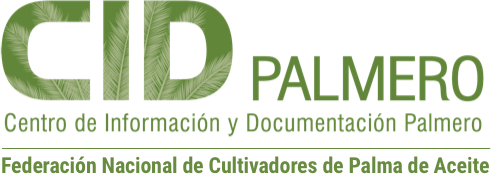Estimación de los costos de extracción de aceite de palma E. guineensis en 2019 para plantas de beneficio ubicadas en la Zona Norte

Author
Guerrero Sánchez, Anderson E.
Muñoz Zambrano, Héctor S.
Obando Coral, Doris del S.
Marsiglia R., Edwin A.
Gantiva S., Juan C.
Muñoz M., Javier A.
Garavito J., Wilson F.
Reina U., Edwin M.
Cala M., Silvia L.
Montoya Mauricio, Mosquera
Estadisticas
Publicación:
Revista Palmas; Vol. 41 Núm. 3 (2020); 24-36
0121-2923
Revista Palmas; Vol. 41 Núm. 3 (2020); 24-36
0121-2923
Abstract
In the Colombian oil palm agroindustry, there is a lack of information regarding the specifics of the costs in which an oil palm mill incurs in order to extract crude palm oil (CPO) from fresh fruit bunches (FFB). The goal of this study was to help filling this gap through proposing a method for estimating the unit costs, which was used for estimating the variable costs in 2019 at mills from the Colombian Northern Zone. In total, nine mills participated in this study. Altogether these mills crushed 1,236,744 tons of fresh fruit bunches (FFB) during 2019, which corresponded to 71% of the total amount of FFB crushed by mills in the Northern Zone during 2019. It must be highlighted that in order to determine the variables used for gathering data, the period to consider and, how to construct indicators; there were various meetings among oil mill managers and researchers from the Colom- bian Oil Palm Research Center (Cenipalma). Results indicate that according to their participation on variable costs, labor represents 48%, maintenance 37%, water and electric power (15%). Additionally, the costs of extracting the crude palm oil (CPO) from a ton of FFB ranged from COP 29,555/t FFB to COP 45,388/t FFB. Consequently, the costs of extracting a ton of CPO ranged from COP 143,749/t CPO to COP 220,761/t CPO. Finally, an interesting result indicated that the installed capacity of the mill, which is often believed to be the most important factor in determining the costs of crushing FFB because of economies of scale, actually plays a secondary rol and it was found that the source of energy ends up being the main driver of the reduction in milling costs. En la agroindustria de palma de aceite en Colombia hay escasez de información detallada de los costos en los que incurre una planta de beneficio para extraer aceite de palma crudo (APC) de racimos de fruta fresca (RFF). El objetivo de este estudio fue ayudar a llenar este vacío, al proponer un método para estimar los costos unitarios, el cual se utilizó para calcular los costos variables en 2019 en plantas de beneficio de la Zona Norte del país. En total, nueve plantas de beneficio participaron en este estudio.
Estas plantas procesaron 1.236.744 toneladas de RFF durante 2019, lo que correspondió a 71 % de la cantidad total de RFF procesado por las plantas de beneficio de la Zona Norte durante 2019. Cabe destacar que, para determinar las variables utilizadas en la recopilación de datos, el periodo a considerar y, cómo construir indicadores, se realizaron varias reuniones entre directores de las plantas de beneficio e investigadores de la Corporación Centro de Investigación en Palma de Aceite (Cenipalma).
Los resultados indican que según la participación en el costo (variable), la mano de obra representa el 48 %, el mantenimiento el 37 % y el agua y la energía 15 %. El costo de extraer el aceite de palma crudo (APC) de una tonelada de RFF osciló entre $ 29.555/t RFF y $ 45.388/t RFF. En consecuencia, los costos de extraer una tone- lada de APC oscilaron entre $ 143.749/t APC y $ 220.761/t APC. Por último, un resultado interesante indicó que la capacidad instalada de la planta, que suele creerse es el factor más importante en la determinación de los costos de procesar RFF debido a la economía de escala, en realidad pasó a un segundo plano, ya que la fuente de energía terminó siendo el factor determinante en la reducción de los costos de extracción.
In the Colombian oil palm agroindustry, there is a lack of information regarding the specifics of the costs in which an oil palm mill incurs in order to extract crude palm oil (CPO) from fresh fruit bunches (FFB). The goal of this study was to help filling this gap through proposing a method for estimating the unit costs, which was used for estimating the variable costs in 2019 at mills from the Colombian Northern Zone. In total, nine mills participated in this study. Altogether these mills crushed 1,236,744 tons of fresh fruit bunches (FFB) during 2019, which corresponded to 71% of the total amount of FFB crushed by mills in the Northern Zone during 2019. It must be highlighted that in order to determine the variables used for gathering data, the period to consider and, how to construct indicators; there were various meetings among oil mill managers and researchers from the Colom- bian Oil Palm Research Center (Cenipalma). Results indicate that according to their participation on variable costs, labor represents 48%, maintenance 37%, water and electric power (15%). Additionally, the costs of extracting the crude palm oil (CPO) from a ton of FFB ranged from COP 29,555/t FFB to COP 45,388/t FFB. Consequently, the costs of extracting a ton of CPO ranged from COP 143,749/t CPO to COP 220,761/t CPO. Finally, an interesting result indicated that the installed capacity of the mill, which is often believed to be the most important factor in determining the costs of crushing FFB because of economies of scale, actually plays a secondary rol and it was found that the source of energy ends up being the main driver of the reduction in milling costs.
Palabras clave:
Unit cost
palm oil mill
E. guineensis
costs comparison
costo unitario
planta de beneficio de aceite de palma
E. guineensis
comparación de costos
Unit cost
palm oil mill
E. guineensis
costs comparison
costo unitario
planta de beneficio de aceite de palma
E. guineensis
comparación de costos


